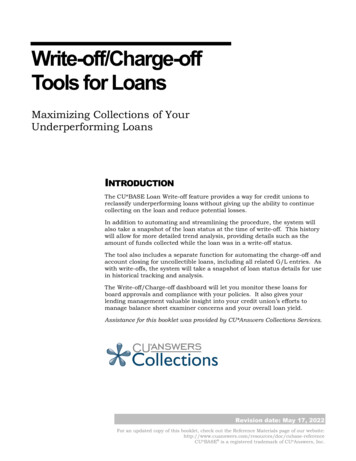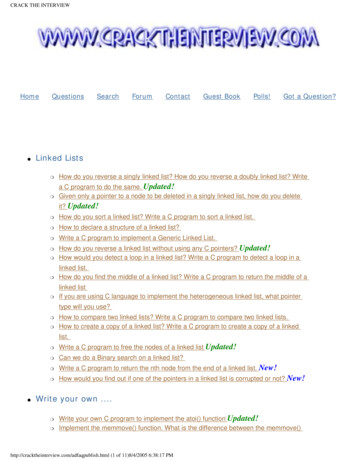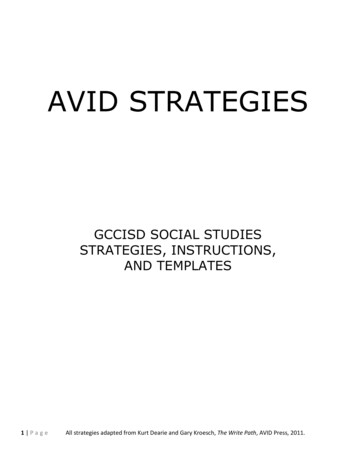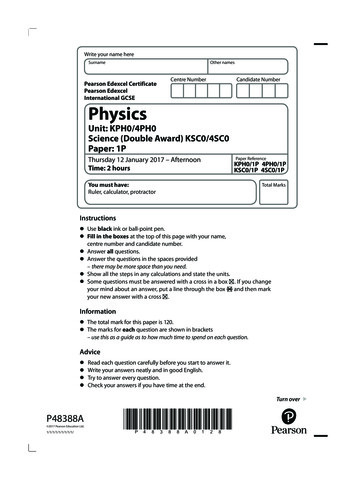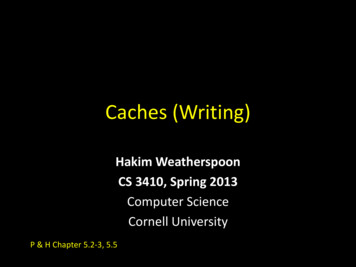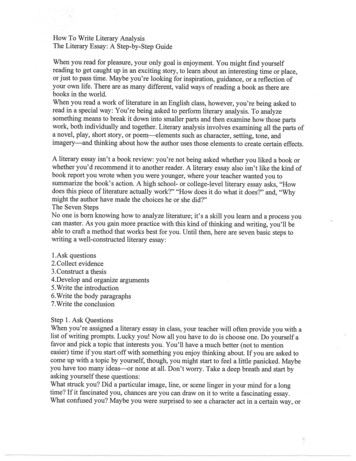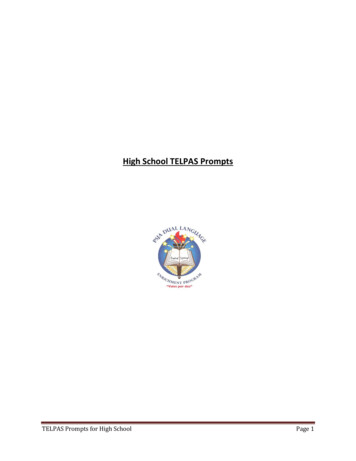
Transcription
How to Write aResearch PaperStudent Success WorkshopsSauk Valley Community College
Choose Your TopicWhen choosing a topic: Find a topic in which you are interested Find a topic that has enough information Find a topic that has a subject that you can manage
Create a thesis statementA thesis statement is a short statement, usually onesentence, that summarizes the main point or your beliefthat you will be writing about in an essay, research paper,etc.
Create a thesis statement Brainstorm the topic - You start out with an idea of what youwant to write about or what you want to uncover in yourpaper. Narrow the topic –Research the topic. Use the information tonarrow the focus of your paper. Take a position on the topic – Take a side and clearly identifyyour position in your thesis statement. Use specific language – You want your reader to know exactlywhat you mean. Make a statement based on clearly stated support – Finally,revise your thesis statement to incorporate all of these points.
Examples of Thesis Statements While both sides fought the Civil War over the issue of slavery,the North fought for moral reasons while the South fought topreserve its own institutions. In Huckleberry Finn, Mark Twain develops a contrast betweenlife on the river and life on the shore.Above examples taken from l
Locate Information Use information from a variety of reference sources. Thesesources include searching the internet, encyclopedias,almanacs, scholarly journals, books, magazines, andnewspapers. When conducting an internet search, it is important to payattention to domain name extensions.edu an educational institution.gov a government institution.org a non-profit organization.edu and .gov sites represent institutions andtend to be more reliable, but be sure to watchout for political bias in some government sites.
Other possible internet searches:SVCC Library rc/databmenu.htmlIn the library, you can also consult guides to periodicals, such as: Education Index Readers Guide International Index to Periodicals Psychological AbstractsERIC http://www.eric.ed.gov/ The Education Resources Information Center (ERIC), sponsored by the Institute ofEducation Sciences (IES) of the U.S. Department of Education, produces the world’spremier database of journal and non-journal education literature. The ERIC onlinesystem provides the public with a centralized ERIC Web site for searching the ERICbibliographic database of more than 1.1 million citations going back to 1966. Morethan 107,000 full-text non-journal documents (issued 1993-2004), previouslyavailable through fee-based services only, are now available for free.
Prepare an OutlineINTRODUCTION What is the main reason you are writing the paper? Explain briefly the major points you plan to cover in your paper andwhy readers should be interested in your topic. End with your your thesis statement.BODY Present your arguments to support your thesis statement. Remember the Rule of 3, find 3 supporting arguments for eachposition you take. Begin with a strong argument, then use a stronger one, and endwith the strongest argument for your final point.CONCLUSION Restate or reword your thesis. Summarize your arguments. Explain why you have come to this particular conclusion
Prepare Notes You should write down anything and everything that will answer yourthesis statement or research question. Be to the point in whatever you write. For major issues, having more than one person who agrees with youstrengthens your point. It's also okay to include opposing views. Using a variety of sources will lend weight to your argument, broadenyour horizons on the topic when you need varying viewpoints anywayand demonstrate to your professor the thoroughness of your research. Skim through your sources, locating the useful material, then makegood notes of it, including quotes and information for footnotes. Be accurate and honest. You can organize your notes on paper or 3x5 index cards for easyshuffling. Number your note cards or pages to keep track of them. Devise your own method to organize your notes. One method may be tomark with a different color ink or use a hi-liter to identify sections inyour outline.
Write A Rough Draft1. In the introduction, tell the reader what you are going to say(statement of purpose)2. Say it (main body of the paper)3. In the conclusion, tell the reader what you'vesaid (statement of summary and conclusion)
Avoid PlagiarismTo avoid plagiarism, write in your own words what youunderstand to be the basic meaning of a sentence or a blockof text (paraphrase the text). Highlighting key passages orphotocopying key pages can be a good first step towardsextracting important information. Before you start yourdraft, translate and rewrite your notable research findingsnow. Don't count on doing it later when the temptation ofkeeping beautifully-crafted sentences in the body of yourpaper (without acknowledgment) is even greater.
Revise Your Rough DraftYou are now ready to polish up the first draft. Try to read your paper as if it were unfamiliar to you. Reading the paper aloud is a good way to be sure that thelanguage is not awkward, and that it "flows" properly. Check for proper spelling, phrasing and sentence construction. Check for proper form on footnotes, quotes and punctuation. Check to see that quotations serve one of the followingpurposes: Show evidence of what an author has said. Avoid misrepresentation through restatement. Save unnecessary writing when ideas have been well expressedby the original author. Check for proper form on tables and graphs.
Prepare Your BibliographyAt the end of your paper, provide a list of all the sources youused to gather information for the paper.For more information on how to create a Works Cited (MLA) orReferences (ALA) page, please visit:MLA format information 01/APA format information http://owl.english.purdue.edu/owl/section/2/10/
Prepare a Title Page andTable of Contents The title page is the first page of the paper. It should includethe title of your paper, your name, and the date on which thepaper is due. Check with your instructor if this page is requiredor if any other information is needed for the title page. The table of contents is the second page (if required). It shouldlist the main topics, important subtopics, and the page onwhich each is introduced in your paper.
Final Checklist Before handing in your paper, be sure you can answer “Yes” toeach of the following questions.Did I include a title page? (if required)Did I include a table of contents? (if required)Did I number all pages correctly? (if required)Did I provide footnotes for quotations and major sources ofinformation?Did I include a bibliography?Did I keep a second copy for my files?
Finding the time to schedule yourprojectIdeally, you will have at least four weeks from the date it'sassigned to complete a research paper of 7 or 8 pages (2,000to 2,500 words).Shorter papers requiring fairly simple research (4 or 5 pages 1,500 words) may not require four weeks' "lead time," while a15 page or longer paper might be a semester-long project.
Finding the time to schedule your projectStep by Step Research & Writing ScheduleDate I willfinish this stepStart Date: March 18thSTEP 1 - Getting started: planning the processMarch 22STEP 2 – Researching and choosing a topicMarch 26STEP 3 – Create your outlineApril 1STEP 4 - Gathering information: detail researchApril 5STEP 5 - Preparing to writeApril 12STEP 6 - Writing and revisingApril 19STEP 7 – Submit paperApril 29th
For more information on MLA or APA formatsvisit the Purdue OWL tion retrieved earchguide.com/1steps.html#step4
assigned to complete a research paper of 7 or 8 pages (2,000 to 2,500 words). Shorter papers requiring fairly simple research (4 or 5 pages - 1,500 words) may not require four weeks' "lead time," while a 15 page or longer paper might be a semester-long project. Finding the time to schedule your project Step by Step Research & Writing Schedule .File Size: 657KB
